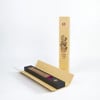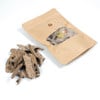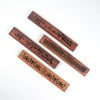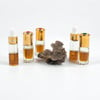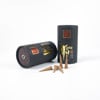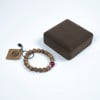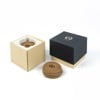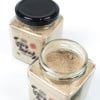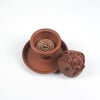What is Agarwood? Revealing the hidden secrets of agarwood
Contrary to common understanding, people are confused, agarwood is not the name of a plant. Agarwood is the wood containing many aromatic resins born from the trunk of the Aquilaria crassna, which grows a lot in the old forests of Vietnam. Agarwood tree is the short way people call Aquilaria crassna to create agarwood. During the process of growth and development, the tree can be eaten by termites, insect pests. Heavy rain, strong wind or the effects of nature create wounds on the tree trunk. Those wounds must be soaked with water through a rainy season before the tree begins to secrete a resin that surrounds the wound to resist infection from the outside.

Over time, the resin gradually thickens, bringing a scent that attracts a rare species of ant. It is a tall, yellow or black ant. This ant is hard to find, it carries a special fungus and comes to eat tree sap. Then accidentally transplanted into that plastic layer, fungi create agarwood. This fungus interacts with the active ingredients of the resin layer, under the influence of the outside climate and the interaction takes place for a very long time, it will produce a special essential oil, which is agarwood. The longer the interaction, the more valuable it is. With the Aquilaria Crassna, there are eyes on the trunk of the tree, those eyes are the vestiges of an insect chiseled into the tree trunk, folk call it a bougainvillea.
Over tens to hundreds of years, under the aura of heaven and earth, the wood cells gradually transform into light brown, gray, indigo, black with many different hard and flexible textures; with very specific oil veins on the bass wood. This is because the deposited oil gradually denatures. The trees that have agarwood are usually fibrous trees and have tumours, tumors, borers, termite mounds, shrapnel from bombs and bullets, broken branches or struck by lightning. Agarwood that has been aged for a long time will have a clearer and stronger scent. Natural Agarwood has an essential oil concentration ranging from 25-80%, of which the most advanced type reaches 60-80%. Many people still think that any tree can produce agarwood. But the truth is not so. In the natural forest, it is estimated that out of 1,000 to 1,500 trees, there may be only 1 Agarwood tree.
Agarwood, according to the Chinese characters, means sinking, while incense is a fragrance, right from the name, it describes the scent characteristics, as deep as the virtues of a gentleman, unobtrusive but ethereal and persistent. And the southern wonders are the miracles of the South; People named it so to show pride in this rare and hard to find wood. Agarwood contains many sesquiterpene compounds, which have a separate structure and cannot be artificially synthesized. Natural products and essential oils extracted by steam distillation are used to produce high quality incenses and perfumes as well as in traditional medicine.

Aquilaria Crassna already has agarwood, this wound is agarwood.
Classification of
According to Dr. Le Cong Kiet, the evaluation criteria for Agarwood is usually based on: Origin, shape, size, color, scent, weight, density, purity and type of tree produced. it. In trading transactions, the classification of Agarwood is largely based on the perception, experience, consensus between the two parties through seeing, touching, burning, tasting, smelling... Agarwood is very diverse, mostly Currently, it is divided into 4 types: Southern States, Agarwood Roots, Agarwoods, and Acceleration.
Aquilaria Crassna Pierre
This is the most special and rarest type of Agarwood. The price of the Aquilaria Crassna Pierre Agarwood is very high, possibly up to billions of dong. Ky Nam is soft, flexible, and pure, when tasting full of sour, spicy, bitter and sweet taste; Natural fragrance with blue smoke, straight and long.
Bai Ky: ivory white, light gray, extremely rare, very oily and soft
Black period: indigo black, tar and hard
Fluorescent: dark yellow or golden brown color like beeswax resin, heavy and hard
Thanh Ky: gray-blue color, green light
Ancient books classified the male period in order of value: "Nhat Bach, Nhi Thanh, Tam Huynh, and Tu Ha".

Aquilaria Crassna Pierre.
Roots Agarwood
Roots Agarwood is also known as type 1 agarwood. This is a type of agarwood with similar properties to the male period but not as perfect as the male period. Roots Agarwood are formed from the roots of Aquilaria Crassna, completely submerged in water. Grade 1 agarwood is very good for health, difficult to exploit, rare, so it has high economic value.
Ant Nest Agarwood
Ant Nest Agarwood are type 2 of agarwood, often with holes and caves created by ants before the tree becomes agarwood. Ant Nest Agarwood are submerged in water, not completely like Roots Agarwood. This is also a rare type of Agarwood in nature and has a price of several hundred million or more.
- Green ants: often found on the trunk of the tree, dark green, hard.
- Ant scorpion: softer, has many shapes.
- Needle ants: run with small, flat ridges, like the seam of a sewing needle.
- Wall ants: eat according to the pattern of a house, it looks like the wall of a building.
- Thorny ant: also known as the old tree ant, also known as the grandfather ant, because the ant eats between the intestines of the do tree, runs the veins.
- Hole ants: eat holes in the gut of the tree.
- White ants: call by color, have the highest price because of good bass quality.
- Black ants smack: there is only agarwood at both ends, the middle of the body is full of rice; In the world of carrying, it is also known as ant evil.
Tock Agarwood
Tock Agarwood is almost contaminated with very little oil, so it is rated as the lowest grade of agarwood; mainly in the form of floating agarwood, agarwood oil is closed from the outside and long along the wood grain of Aquilaria Crassna. Solid Agarwood, no holes, and caves. Tock Agarwood is the most popular on the market today. Agarwood has many different selling prices, ranging from a few hundred to several million dongs.
There are several dozen types of speed such as:
- Tock Flower: pale yellow color, with speckled dots like flowers.
- Tock Water : light yellow color, wet and heavy substance.
- Tock Gray: gray-blue color like ash.
- Tock Slow: black as soot.
- Tock Rock: heavy and looks like a rock.
- Tock Quick: pale yellow color, spicy like Siamese chili.
- Huong Tock: pale yellow color, strong fragrance, often surrounds the male period, so at some points, many male veins are mixed in.
Characteristics of Agarwood
Colour
Agarwood is an essential oil produced from the sap of Aquilaria Crassna when it is injured. Therefore, depending on the degree of oil contamination of the wood, agarwood has different colors.

The color of agarwood is displayed by the agarwood color palette
The wood of Aquilaria crassna is very light, porous, and has an ivory white color. Depending on the amount of oil contaminated with the wood, the color changes. From gray, brown gradually turns to black with different shades. The more oil, the darker and heavier the seed. When a certain level of oil is reached, the agarwood will sink, usually over 40%; It is often called type 1 agarwood or submerged agarwood.
Fragrant
Agarwood has a very unique smell, unlike the scent of other woods. This is also the most accurate method to distinguish agarwood. Depending on the soil, climate, altitude, and tree varieties, agarwood produces different scents. Basically, a block of wood with a lot of agarwood essential oil when burned will smell a deep sweetness, a warm aroma, not dark or strong, agitated, deposited and long-lasting. Low smoke is white, flying vertically.
With the mutant agarwood blocks, with a living aroma, the smell of agarwood will be mild and cool like the smell of honey mixed with flowers, it is difficult to describe all the aftertaste of the natural scent of agarwood. There is one thing to note, when burning agarwood pieces or blocks to check the quality, you should burn it in a blue flame, choose areas with a lot of oil and lightly burn to create smoke. Only then can you fully enjoy the taste of nature's gift. Absolutely do not burn into fire, because if burned like that, it will burn oil, cause burning, the aroma of agarwood will be affected, the quality will be greatly reduced, no longer accurate.
The value of Agarwood
Unlike other trees, the quality of agarwood is not based on the age of the tubers but on the age of the disease. Depending on the "location" of each tree, the quality of Agarwood will vary. Each plant will have a unique color, flavor and taste. So if calculating the value of agarwood by "age" is not accurate. The quality of agarwood is measured by the aroma and content of the essential oil contained in the wood. If the above two factors are missing, even though the tree is 1000 years old, but if it does not produce agarwood, the tree will not have any value.
With agarwood family, who have been attached to agarwood for their whole life, with rich experience, they will never cut down those trees if they do not see signs of agarwood birth. The old trees but healthy bodies will not be exploited, very wasteful. They are often kept for seed collection as well as for shade. Because Aquilaria crassna trees, if it does not produce agarwood, will only be used to make firewood or paper. Because the wood is very soft, porous and light; The quality is not good to make handicrafts like other types of wood. Many people still say: Having to suffer injuries to turn into agarwood is the cause and condition of the Aquilaria crassna, born like that.
Distribution of frankincense
In the world, agarwood is concentrated mainly in 6 countries: Vietnam, Laos, Cambodia, Myanmar, Indonesia, Malaysia, in which Vietnamese agarwood has the best pharmacology. Recent scientific studies on agarwood by Japanese and Chinese scientists also confirm that Vietnamese agarwood has many active ingredients that agarwood in other places does not have.
- Vietnamese Agarwood: Nha Trang, Hue, Phu Yen (Hong Tho), Quang Ngai (Southern period, agarwood, red earth).
- Chinese Agarwood: Cantonese incense, Hainan incense, Hong Kong incense, Guangxi, Yunnan, Taiwan.
- Indonesian Agarwood: Agarwood from Illion province, Aceh province, Sumatra island, Sulawesi island, Lombox province, An Han island, Kalimantan island.
- Agarwood from Laos: Luang Prabang, Champasak, Aso Po.
- Cambodian Agarwood.
- Thai Agarwood.
- Burmese Agarwood.
- Filipino Agarwood.
- Brunei frankincense.
- East Timor Frankincense.
- Malaysian Agarwood.
- Agarwood Papua New Guinea
Agarwood systems
- Hue An:
- Meet up place: Hoi An - Vietnam.
- Agarwood production areas: Vietnam, Laos, Myanmar, Cambodia, Thailand, India
- Quan Huong:
- Meet up place: Dong Quan.
- Agarwood production areas: Hai Nam, Hong Kon, Quang Tay.
- Tinh Chau:
- Meet up location: Singapore.
- Agarwood production areas: Indonesia, Malaysia, Philippines, Brunei, Papua New Guinea.


























